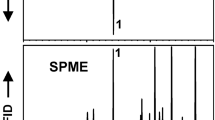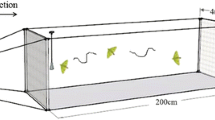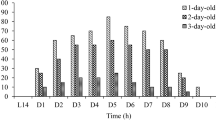Abstract
Pheromone washes from calling female moths of redbacked cutworm,Euxoa ochrogaster (Guenée), contained the following acetates that are structurally similar to those of known lepidopteran pheromones (%): decanyl (8.7), dodecanyl (8.5), (E)-5-dodecenyl (3.3), (Z)-5-dodecenyl (76.4), (Z)-7-dodecenyl (3.1), and (Z)-9-dodecenyl (trace<0.5%). This is the first time that (Z)-5-dodecenyl acetate has been identified as a pheromone component. Three types of specific receptor cells were found in the male antennae, and they responded to (Z)-5-decenyl acetate, (Z)-5- and (Z)-7-dodecenyl acetates, respectively. Strong electroantennographic detector responses were also recorded for these three acetates and for (Z)-5-undecenyl acetate. The evidence for the presence of (Z)-5-decenyl acetate in the pheromone washes was inconclusive. The presence of (Z)-7- and the absence of (Z)-8-dodecenyl acetates were confirmed by a special electroantennographic detector technique in which the detector antennae were from males of other species that were known to have strong responses to these acetates. This is a very useful technique. Field results show that low concentrations (0.1–1.3%) of (Z)-5-decenyl acetate were synergistic when tested in a previously reported blend, but 6% was inhibitory. Similarly, (Z)-7-dodecenyl acetate at 2% or less may be essential for the attraction of males, but in previous tests at 14% it also was inhibitory. Species-specific attractant blends for redbacked cutworm males are described.
Similar content being viewed by others
References
Arn, H., Städler, E., andRauscher, S. 1975. The electroantennographic detector—a selective and sensitive tool in the gas chromatographic analysis of insect pheromones.Z. Naturforsch. 30C:722–725.
Beroza, M., andBierl, B.A. 1967. Rapid determination of olefin position in organic compounds in microgram range by ozonolysis and gas chromatography.Anal. Chem. 39:1131–1135.
Budzikiewicz, H., Djerassi, C., andWilliams, D.H. 1967. Mass Spectrometry of Organic Compounds. Holden-Day, San Francisco.
Cardé, R.T., andRoelofs, W.L. 1977. Attraction of redbanded leaf-roller moths,Argyrotaenia velutinana, to blends of (Z)- and (E)-11-tridecenyl acetates.J. Chem. Ecol. 3:143–149.
Chisholm, M.D., Steck, W.F., andUnderhill, E.W. 1978. Geometrical and positional isomerization of alkenyl acetates produced by hydrogenation of alkynyl acetates over palladium metal catalysts.J. Chem. Ecol. 4:657–663.
Granges, J., andBaggiolini, M. 1971. Une phéromone sexuelle synthétique attractive pour le carpocapse des prunes (Grapholitha funebrana Tr. (Lep. Tortricidae)).Rev. Suisse Vitic. Arboric. 3:93–94.
Grob, K., andGrob, G. 1976. A new, generally applicable procedure for the preparation of glass capillary columns.J. Chromatogr. 125:471–485.
Hill, A.S., andRoelofs, W.L. 1975. Sex pheromone components of the omnivorous leafroller moth,Platynota stultana.J. Chem. Ecol. 1:91–99.
Hill, A.S., Roelofs, W.L., Rings, R.W., andSwier, S.R. 1977. Sex pheromone of the black cutworm moth,Agrotis ipsilon (Hufnagel) (Lepidoptera: Noctuidae).J. N. Y. Entomol. Soc. 85:179–180.
Priesner, E. 1979. Specificity studies on pheromone receptors in noctuid and tortricid Lepidoptera, pp. 57–71in F.J. Ritter (ed.). Chemical Ecology: Odour Communication in Animals. North-Holland, Amsterdam.
Shorey, H.H., andHale, R.L. 1965. Mass-rearing of the larvae of nine noctuid species on a simple artificial medium.J. Econ. Entomol. 58:522–524.
Sower, L.L., Coffelt, J.A., andVick, K.W. 1973. Sex pheromones: a simple method of obtaining relatively pure material from females of five species of moths.J. Econ. Entomol. 66:1220–1222.
Steck, W., Chisholm, M.D., Underhill, E.W., andPeters, C.C. 1980. Optimized conditions for sex attractant trapping of male redbacked cutworm moths,Euxoa ochrogaster (Guenée).J. Chem. Ecol. 6:585–591.
Struble, D.L., andJacobson, L.A. 1970. A sex pheromone in the redbacked cutworm.J. Econ. Entomol. 63:841–844.
Struble, D.L., andSwailes, G.E. 1978. Sex attractant for adult males of the redbacked cutworm,Euxoa ochrogaster.Environ. Entomol. 7:384–386.
Tumlinson, J.H., Heath, R.R., andDoolittle, R.E. 1974. Application of chemical ionization mass spectrometry of epoxides to the determination of olefin position in aliphatic chains.Anal. Chem. 46:1309–1312.
Author information
Authors and Affiliations
Additional information
Lepidoptera: Noctuidae
Rights and permissions
About this article
Cite this article
Struble, D.L., Buser, H.R., Arn, H. et al. Identification of sex pheromone components of redbacked cutworm,Euxoa ochrogaster, and modification of sex attractant blend for adult males. J Chem Ecol 6, 573–584 (1980). https://doi.org/10.1007/BF00987669
Received:
Revised:
Issue Date:
DOI: https://doi.org/10.1007/BF00987669




